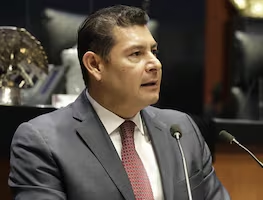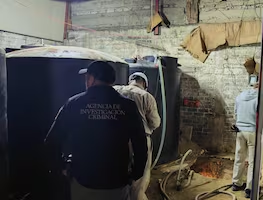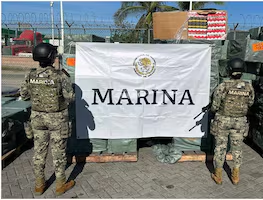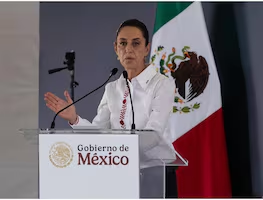Más Información

Alejandro Armenta: Vamos a defender con Sheinbaum a los migrantes; los poblanos son forjadores de “Pueblayork”

FGR asegura 15 mil litros de hidrocarburo en el Estado de México; deshabilitan dos tomas clandestinas

Marina asegura más de 240 mil cajetillas de cigarros apócrifos en el puerto de Manzanillo; el valor de la mercancía asciende a 19 mdp

Senadores del PRI exigen frenar propaganda de la 4T en Edomex; denuncian que imponer frases de AMLO como nombres de calles es una afrenta
Researchers from the National Autonomous University of Mexico (UNAM) and the National Institute of Anthropology and History (INAH) deciphered that Cobá , a pre-Hispanic city located in Quintana Roo, had 14 governors in its prime, near 500 A.D.
The interpretation was done from the study of the Panel 7 of Cobá’s Navarrete Group’s Ball Game, as well as other 59 sculpted monuments that include steles, altars, lintels, and reliefs with images and/or texts, made by archeologists, epigraphists, and restaurateurs that are part of the Cobá Project, led by archeologist María José Con.
According to the study of the monuments, near 500 A.D., in the Early Classic period, Ju’npik Tok (The one with 8,000 flints) founded a bloodline whose hegemony would be a rival, in territorial terms, to those in Tikal and Calakmul.

From the 59 sculpted monuments, epigraphists Octavio Esparza, from the UNAM’s Maya Studies Center, nine could be totally or partially translated: K'ahk' Chitam (Fire Peccary); Uxman; ... K'awiil; Yopaat Taj ... Naaj; Ixik ... Yopaat (Lady Yopaat); ... K'ahk' ... Yopaat (Fire Yopaat); Kalo'mte' ...; and Xaman K'awiil (North K'awiil), in addition to Ju'npik Tok'.
Recommended:
“The use of dashes suggests there is a part of the name we cannot read, whereas the five governors whose anthroponym we ignore are designated with a capital letter: A, B, C, D, and, E,” said Esparza.
The epigraphist also identified the ties Cobá had with settlements in the area on a supra-regional level, and to the knowledge of local information, for instance, that one of the most important governors in the city was a woman: Ixik... Yopaat, who – during an administration that lasted approximately 40 years, by the beginning og the 7th century – would have boosted Cobá’s power in a substantial way.
“The hieroglyphics show a logogram with an anthropomorphic profile that is read like ‘ixik,’ whose translation is ‘woman or lady’ and that tells us the carácter was female,” said Esperaza and said that even though it was not a rule for the Maya, important cities like Palenque and Naranjo were once governed by women.
María José Con and Octavo Esparza agree that Cobá had a supra-regional influence , a characteristic that can be noticed, even, in archeological areas like Edzná, also in Campeche, and Tikal, in Guatemala, where experts have found evidence of contact, whether over war or diplomacy, with the city of the “Turbid Waters,” the meaning of Cobá’s ancient place name (Kobha´).
Although the government periods and the chronological order of the 14 governors are not quite clear, Coba’s monuments allude to this bloodline until 780 A.D., so the end of this group of governors is thought to have taken place toward the end of the 8th century.
Despite the explanation about the 14 governors, María José Con stressed that it does not mean that the place had only been ruled by this political class, since Cobá , due to its ideal location near four lagoons, has its most early antecedents as a settlement on 200 B.C.
The Cobá Project began in 1992 and since then, six architectonical groups of the archeological site have been studied: Cobá, Navarrete, Nonoch Mil, Copó, Maya, and Macanxoc; the latter is where explorations and the consolidation of the nine structures have been focused.
Recommended:
Structure 5 stands out from Macanxoc’s nine structures, “we consider it one of the most relevant from the religious perspective since it is located at the center of a compound surrounded by a fence with four entrances that culminate in altars at its foot. The main entrance was done through a long, vaulted room, which led to the structure and to another altar, at the foot of the building,” said María José Con.
Another two steles were recently found in Macanxoc, although they are in a poor state of conservation, for a total of 10 in this area of Cobá.
As part of the works in Cobá , as explained by Vania Pérez from the UNAM’s postgraduate course of Mesoamerican Studies, there have been topographic surveys in the site that consist of a registry of structures, topography, and planimetric and altimetric restitution.

“Now we have a more precise map of the site’s core and we can reconsider specific data, such as those relate to the height of Nonoch Mul, the site’s tallest structure, which was thought to be 40 meters tall, but that is actually 39,” said Pérez.
The expert said that, as part of the topographic surveys, they have also discovered vestiges of a platform that enclosed the Navarrete Group’s Ball Game, giving it a higher status linked to its Access, as well as a group of patios reused inside the Cobá Group.
mp






